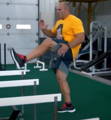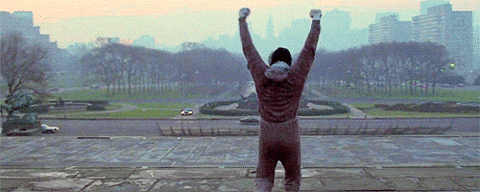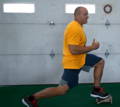Plyometrics for SPEED
Plyometrics are incredible. As an exercise movement, plyometrics are one of the top dogs in the department of building speed, power, and explosiveness. There is a saying that an athlete can become pretty strong just from jumping. Now, we think lifting weights contribute greatly to strength (because they do!), but we also are firm believers in the utility of plyometrics for speed development.

Because of that belief, we want to share with everyone the best plyometric exercises to improve speed. With that in mind, the first two exercises we are going to utilize are pretty simple, almost warm-up style plyometric movements. Let’s jump into the workout (pun intended).
1. Single Leg Good Morning To Hip Lock
Using a PowerLastic band anchored to an unmovable object and wrapped around the neck, we want to bend at the hip to perform the single leg good morning. This will lengthen the hamstring. Once the hamstring is lengthened we want to come through with the other leg into a hip-lock and hold.
We want to do two to three sets of four to five reps on each leg. The goal is to really focus on pulling from the hamstring while staying upright, especially at the top. This will help open up the hammies, the posterior chain, and the lower back. It will also help with speed out of the start into acceleration as we transition into top-end speed. Strictly from a track mindset of speed, all of the movements we are recommending will play into one or more of the phases: the start, acceleration, drive phase, into top-end speed with maximal mechanics.
We pair the single leg good morning to hip lock with the next movement.
2. Side Skips Over Hurdles
The goal of these side skips is to really wake up the hips. What we see with this movement, especially with football players, is that the athletes tend to shuffle their knees, failing to drive their knees up at higher speeds. This movement helps the body get a little bit more hip flexion when trying to drive quicker.

We want to do two to three sets of four or five reps with each leg. Try to avoid having too much flexion in the knee when performing this movement. Coaches need to pick up on athletes limitations in their knee extension, hamstrings, or hips.
The good thing is these two movements can be used to lengthen the hamstrings and wake-up the hips which will help with the rest of this plyometric workout.
3. Seated Tuck Jump
Now that we are pretty loose and warm, the next step is to do a seated tuck jump using two different boxes. With the first box, we will be a little bit higher. We want to focus on our start here. This movement will help with the start position.
Sitting on the box, we want to get a slight rock and think of pulling from the full foot, hamstrings, and extending the hips. Do two jumps. Immediately after, we want to come down to the lower box; we will be a little weaker from this position. Athletes may be stiff in the hips to cause that weakness. Again perform two jumps from this lower height.
We want to do two to three sets of a combined four jumps. We also want to pair this movement with the next movement.
4. Single Leg Stair Jumps
Resting thirty to sixty seconds after the previous movement, we want to head over to a set of stairs to perform some unilateral jumps. Single leg stair jumps are one of the best unilateral movements to increase acceleration and increase the drive phase because of the angle the knee is forced to be in coming up the steps. This makes athletes really have to project themselves.
We can’t stress enough the benefits of unilateral movements, especially when talking about stair jumps. What happens is the weaker side is exposed. This information can be used to improve strength on that specific side.

We recommend doing the weaker side first. We also think it is very important to be engaged with the sound of the movement. The auditory cadence of an elephant isn’t as desirable as that of a ninja in this case. The sound of a ninja (being quiet) hints at a more reactive jump that is quicker and more explosive.
5. Russian Lunges
These next two plyometric movements focus on the drive phase, acceleration phase, and on transition work. Russian lunges are a movement that a lot of athletes can do. It can be done by anyone training for just about anything.
We want to hold the lunge basically at a ninety degree angle. From there, we quickly alternate the foot that is forward and hold again. We then go back and forth in this manner, remembering to pause with the isometric muscular action in the lunge.

We want to do two to three sets for ten reps, getting five reps on each leg. This movement is great for the rapid change of direction and the rapid movement of the knees.
6. Champion Strides
This movement is paired with the Russian lunges. Having rested thirty to sixty seconds after the last movement between sets, we want to do champion strides. It focuses on transition work into top-end speed.
This is a movement that allows athletes who are explosive off of one leg and two legs will have better carryover to whatever sport is being trained for. This movement is difficult and challenging. It is performed from a bound. We go double leg, single leg, double leg, single leg, switching the single leg bound from one leg to the other. Think of it like this: double leg bound, right leg bound, double leg bound, left leg bound. We can go either leg first with the single leg bound.

This movement is complicated. It is hard. It requires more coordination than the previous movements. Athletes need this challenge. As coaches we need to encourage them to really attack during champion strides. We want athletes holding good posture, driving their knees, and having good dynamic trunk control.
Do two to three sets of this series of jumps.
7. Split Squat Iso Hold Heel Elevated
This is the last pairing coming up. Think about the drive phase and a little bit of transition into top end speed. with this movement.
We want to hold this position pretty upright for about twenty to thirty seconds. The whole goal is to be stable through the ankle, knee, and hip while the posture is upright. After holding the position with the one leg, we want to then switch and hold it with the other leg.

This is a great exercise for every and any athlete. We want to do this movement for two to three sets.
8. Single Leg Mini Hurdle Hops
After resting for thirty seconds to a minute after a set of the split squat isometric hold heel elevated exercise, we want this next movement to focus more on a flat foot grounding (not entirely flat) but mimicking maximal mechanics. This means we want the posture upright as well, mid-foot grounding a little bit, and a solid knee drive.
We can utilize the sound and the distance athletes are performing the movement to assess. We can also pay attention to athletes' foot positions.
Do this movement for two to three sets of four to five jumps with each leg
Recap
We can utilize plyometric movements not just for the strength and rigidness that will be gained that leads to greater speed, but we can also look at how athletes are grounding, take those cues, and enhance athletes overall training.
Do all these movements as a workout once a week to improve all aspects of speed. These movements will help with the start, the drive phase, acceleration, and top-end speed with maximal mechanics.
Go give the workout a go and let us know how it goes by commenting below
DANE MILLER
Dane Miller is the owner and founder of Garage Strength Sports Performance. He works with a select handful of clients on building comprehensive programs for fitness and nutrition. Several times a year he leads a workshop for coaches, trainers, and fitness enthusiasts.


